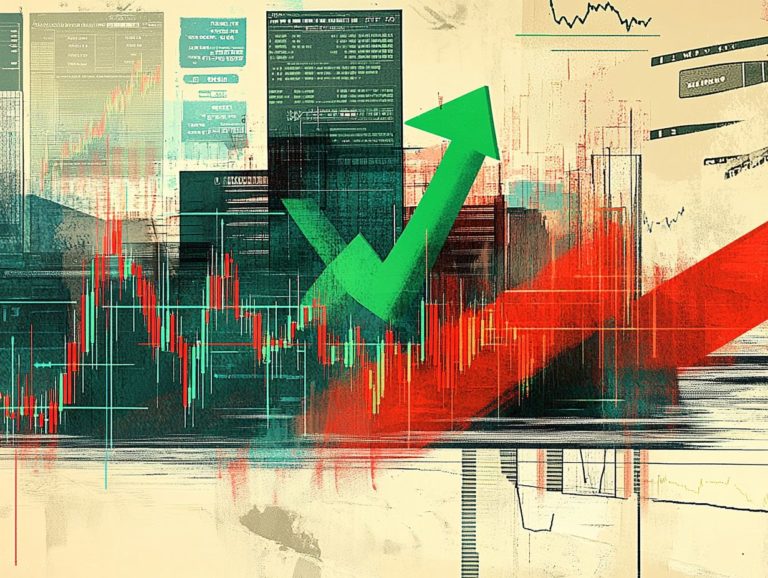What is Market Capitalization?
Market capitalization is an essential concept for anyone looking to navigate the financial landscape of public companies. It acts as a snapshot of a company’s market value, significantly influencing your investment decisions and shaping perceptions of growth potential.
This article delves into what market capitalization truly is, why it holds such importance, and the various factors that can affect its value, from company size to broader economic conditions. It also outlines how to calculate market capitalization, interpret its significance alongside other financial metrics, and recognize its limitations.
Whether you re an investor or simply curious about finance, this guide is designed to enhance your understanding of market capitalization and its crucial role in the stock market.
Contents
Key Takeaways:

- Market cap measures a company’s stock market value.
- Factors like company size, performance, industry, and economic conditions influence market cap.
- To calculate market cap, multiply the current stock price by the number of outstanding shares.
Understanding Market Capitalization
Market capitalization, short for market cap, is an essential financial metric that reflects the total value of a publicly traded company. It s calculated by multiplying the current share price by the number of outstanding shares. This figure is vital for you as an investor, offering valuable insights into a company’s relative size and financial performance.
Understanding market cap gives you the power to make more informed investment decisions.
Definition and Importance
Market capitalization is a fundamental measure for assessing the financial performance of public corporations, effectively indicating their market value and overall stability in the stock market.
For you as an investor, understanding market capitalization is essential; it enables you to gauge the relative size of a company and its position in the marketplace. A company’s market cap classifies it into various segments large-cap, mid-cap, and small-cap each signaling different risk and growth potentials.
Large-cap companies, like Apple Inc. and Microsoft Corp., tend to exhibit a higher degree of stability and resilience, making them particularly appealing to risk-averse investors. Their extensive market presence often leads to consistent revenue streams and reliable dividend payouts.
On the other hand, mid-cap and small-cap companies can present significant growth potential but are often accompanied by increased volatility and risk. For instance, a small-cap company might experience dramatic price swings; however, the possibility of higher returns can be appealing to those who seek growth.
Grasping how market dynamics fluctuate is crucial for effective asset allocation, which involves choosing how to distribute your investments among different assets. Shifts in market cap can significantly influence your investment strategies, allowing you to balance your portfolio based on growth potential while keeping inherent risks in check.
Factors Affecting Market Capitalization
Various factors influence market capitalization, including the size of the company, its financial performance, and broader economic indicators. Market risks also play a crucial role in shaping the market price of stocks.
Understanding these elements can provide valuable insights into how market capitalization evolves over time.
Company Size and Performance

The size of a company measured by its market capitalization plays a pivotal role in shaping its stability and financial performance, which in turn directly impacts stockholder value.
Typically, companies fall into three primary categories: large-cap, mid-cap, and small-cap. Large-cap companies, like Apple Inc. and Microsoft Corp., tend to exhibit a higher degree of stability and resilience, making them particularly appealing to risk-averse investors. Their extensive market presence often leads to consistent revenue streams and reliable dividend payouts.
Mid-cap and small-cap companies can present significant growth potential but are often accompanied by increased volatility and risk. Grasping these dynamics is essential for crafting investment strategies that align with your financial goals and risk tolerance.
Understanding these dynamics today can empower your investment strategies for a more prosperous tomorrow.
Industry and Economic Conditions
Industry dynamics and economic conditions play a significant role in shaping market capitalization. They influence market trends and volatility, ultimately affecting stock prices.
You ll notice that different sectors respond distinctly to fluctuations in economic indicators such as GDP growth, unemployment rates, and inflation. These indicators mold their overall performance.
For example, during periods of robust economic expansion, consumer spending tends to rise. This benefits sectors like retail and technology, driving their market caps higher.
On the flip side, when economic signals suggest a downturn, defensive industries like utilities and healthcare often draw increased investor interest due to their relative stability. This leads to diverse capital allocations across various sectors.
By grasping these correlations, you can gain valuable insights into potential market movements, empowering you to make more informed investment decisions.
Calculating Market Capitalization
Calculating market capitalization is quite simple. You multiply a company’s share price by its total number of outstanding shares. This offers a clear snapshot of the company’s valuation within the stock market.
This straightforward formula allows you to gauge how the market perceives the company’s worth at any given moment.
Formula and Examples
The formula for calculating market capitalization is straightforward: multiply the current stock price by the total outstanding shares to attain a clear measure of the company’s market value.
For instance, imagine a tech company with 1 million shares outstanding, and its stock is trading at $50 per share. This results in a market cap of $50 million.
However, if market volatility causes the share price to tumble to $30, the market cap would drop to $30 million. This highlights how sensitive these calculations can be to fluctuations in share price.
Take a well-known company like Apple as an example. When its stock price soared to $150, its market cap reached an astonishing $2.5 trillion, underscoring its dominance in the market. Yet, even minor fluctuations in stock price can dramatically shift investor perceptions and influence decision-making across the board.
Interpreting Market Capitalization

Interpreting market capitalization requires you to compare it with other financial metrics. This comparison allows for a deeper understanding of a company’s valuation and its potential for growth.
This nuanced analysis can significantly influence your investment decisions, empowering you to make informed choices in the market.
Comparison to Other Metrics
Comparing market capitalization to other metrics unlocks deeper insights into a company s financial performance and your potential investment choices.
Market capitalization reveals the total market value of a company s outstanding shares, offering a quick overview of its size and relative standing within the industry.
On the other hand, enterprise value encompasses the total worth of the company, including both debt and cash reserves. This distinction is vital when evaluating mergers or acquisitions, as grasping a company s true worth can significantly shape your strategies.
For example, if a company boasts a high market cap but carries considerable debt, it might not be as appealing, prompting you to rethink your investment position.
Similarly, comparing these metrics alongside price-to-earnings ratios which measure a company’s current share price relative to its earnings per share helps you develop a comprehensive investment thesis. This enables you to make informed decisions that align with your risk tolerance.
Limitations of Market Capitalization
Market capitalization is a powerful tool for investors! However, it has its limits that you need to understand.
While it serves as a useful metric, it often falls short in accurately reflecting a company’s true value and has faced criticism for its association with market risks and volatility levels.
These factors can easily mislead investors, making it essential to approach market cap with a discerning eye.
Shortcomings and Criticisms
Critics argue that market capitalization can misrepresent a company’s true worth, particularly in volatile markets. Share prices might not accurately reflect the actual business fundamentals.
During downturns, a company’s stock may plummet due to panic selling. This creates a misleadingly low market cap that can overlook solid assets and growth potential.
In contrast, inflated stock prices during market bubbles can create an illusion of high value. This tempts investors to invest in overvalued companies.
Such fluctuations can lead to significant losses when a company’s financial health becomes apparent. Shareholders may face harsh consequences if they rely solely on market capitalization for their decisions.
Frequently Asked Questions

What is Market Capitalization?
Market capitalization measures a company’s worth. It s calculated by multiplying the total number of outstanding shares by the current market price per share.
How is Market Capitalization calculated?
It s calculated by multiplying the number of outstanding shares by the current market price per share.
Why is Market Capitalization important?
Understanding market capitalization is crucial! It gives investors insights into a company s size and value, allowing for comparisons within the same industry.
What is considered a large Market Capitalization?
A market capitalization of $10 billion or more typically indicates a large company.
How does Market Capitalization affect a company’s stock price?
Market capitalization reflects a company’s perceived value by investors. A higher market cap often leads to a higher stock price, and the opposite is also true.
Can Market Capitalization change over time?
Yes, market capitalization fluctuates as a company’s stock price and the number of outstanding shares change. Various factors, such as market trends and economic conditions, influence this.






